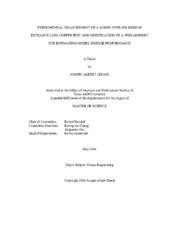| dc.description.abstract | Cutter suction dredges are used in a multitude of scenarios, as they are mobile and efficient. One such situation includes dredge sites where debris could be present. In a location with the possibility of debris impeding the cutter suction dredge centrifugal pump, often a screen is placed over the suction line entrance. Although this prevents the inflow of large debris, it increases the entrance loss of the system. The objective of the study is to determine the minor loss coefficient of the Center for Dredging Studies’ model cutter suction dredge. Testing was completed over the spectrum of specific gravities (SG) and flow rates achievable in the laboratory. The results show that the minor loss coefficient of the screen is a function of specific gravity and velocity, and varies between approximately 1.4 and 2.4 for the model laboratory dredge. Above the critical velocity the loss coefficient increases nearly linearly with specific gravity, if velocity is held constant. Similarly, if specific gravity is held constant the losses increase linearly with velocity. Additionally, as specific gravity is increased, the screen losses become a weaker function of velocity. Higher losses were observed at large specific gravities, as the flow rate decreased below the critical flow rate of the system. The production losses associated with the screen for the model cutter suction dredge were calculated using the pump characteristic curves. They showed variations between 2.4% and 3.4%, presenting larger production losses at higher pump speeds.
An additional aspect of the study concerned comparing the experimental data with that of a widely accepted theoretical method. A previously existing spreadsheet from the Center for Dredging Studies (CDS) was modified to accommodate the minor loss values of the screen, along with the characteristics of the model laboratory dredge and intake losses. The spreadsheet outputs the predicted head loss of the system according to the flow rate and specific gravity, which was compared to the experimental head loss of the study. The theoretical methods matched the experimental results more closely at higher flow rates, achieving approximately 5.7% (no screen) and 6.9% (screen) average error for the suction line at a flow rate of 25.2 L/sec (400 GPM) and 9.4% in the discharge line at a flow rate of 18.9 L/sec (300 GPM). The modified spreadsheet allows the user to input whether or not the screen is present and predict pump performance at a specified specific gravity for a range of flow rates. | en |


